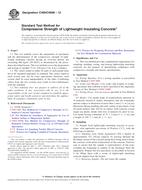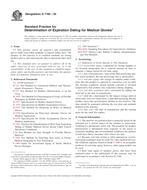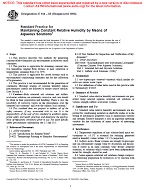1.1 This practice defines a set of terms, procedures, and data required to define the accurate location and description of geospatial data for surface coal mining operations (CMO), underground coal mining extents, land reclamation and performance bond statuses, lands unsuitable for mining petitions (LUMP) and designated areas, coal spoil and refuse features, coal preparation plants, environmental resource monitoring locations (ERMLs), and postmining land uses.
1.2 This practice addresses mining geospatial data relative to the Surface Mining Control and Reclamation Act of 1977 (SMCRA). This geospatial data shall be obtained from each state, tribal, or federal coal mining regulatory authority (RA), or combinations thereof, authorized under SMCRA to regulate CMOs.
1.3 Units – The values stated in inch-pound units are to be regarded as standard. No other units of measurement are included in this standard
1.4 This standard does not purport to address all of the safety concerns, if any, associated with its use. It is the responsibility of the user of this standard to establish appropriate safety and health practices and determine the applicability of regulator limitations prior to use.
1.4.1 This practice offers a set of instructions for performing one or more specific operations. This document cannot replace education or experience and should be used in conjunction with professional judgment. Not all aspects of this practice may be applicable in all circumstances. This ASTM standard is not intended to represent or replace the adequacy of a professional service, nor should this document be applied without consideration of a project's many unique aspects. The word “Standard“ in the title of this document means only that the document has been approved through the ASTM consensus process.
1.5 This practice applies to pre-SMCRA or post-SMCRA coal mining features or both.
1.6 Surface CMOs – As used in this practice, a surface CMO represents an area where coal removal, reclamation, and related supporting activities have occurred, is occurring, is pending authorization or is authorized by the RA within a defined surface CMO or any other unpermitted area that has been identified by the RA prior to SMCRA.
1.6.1 This practice addresses coal mining geospatial data relative to SMCRA, interim permits, permanent program permits, as well as CMOs before the enactment of SMCRA. Each RA shall be the authoritative data source (ADS) for coal mining geospatial data.
1.7 Underground Coal Mining Extents – This practice addresses underground coal mining extents that represent an area where coal removal has occurred within a defined underground CMO.
1.8 Land Reclamation Status – This practice addresses the land reclamation status of surface areas within a permitted CMO where coal removal, reclamation and related supporting activities has occurred, is occurring, or is planned and authorized by the RA.
1.9 Performance Bond Status – This practice shows the status of coal mine reclamation as outlined by each phase of reclamation that can result in bond release, according to SMCRA, 30 CFR Part 700 et seq, and 30 CFR Part 800, et seq. In addition to defining the status of individual areas covered by a performance bond, use of this standard will identify the changes of the reclamation and bond status to mined areas as they change over time. Reference to bond status means performance bond status.
Note 1 – A single bond may cover multiple permits or multiple bonds may cover a single permit.
1.10 Lands Unsuitable for Mining Petition – This practice addresses boundary data pertaining to areas that have been petitioned and designated as unsuitable for mining relative to Title V Section 522 of the SMCRA. It also addresses those lands that have been found by the RA's process to be designated unsuitable for all or certain types of mining. These areas may be petitioned to be unsuitable for CMOs because they meet criterion that include, but are not limited to: fragile, historic, cultural, scientific, having esthetic values and natural systems such as aquifers that could be significantly damaged due to a CMO.
1.11 Refuse Structures – This practice addresses excess spoil and refuse features produced by CMOs. These features include excess spoil structures, coal refuse structures, and coal preparation plants.
1.11.1 Excess Spoil Structures – These structures are created when the total spoil produced during mining exceeds the volume of material that can be utilized for reclamation. This occurrence is common in steep slope areas, where the final grade of reclaimed slopes is limited by stability requirements. It also occurs where overburden volume is significantly larger than the volume of minable coal. Spoil also exhibits a net increase in volume due to the introduction of void spaces in fragmented rock when overburden is removed to expose underlying coal seams. The production of excess spoil requires the creation of disposal structures that extend outside the mined area.
1.11.2 Coal Preparation Plants – Facilities where impurities are removed from coal and potentially crushed, resized, and blended with other grades of coal. Preparation plants produce refuse as a byproduct.
1.11.3 Refuse – A waste byproduct of coal processing, generally categorized as either coarse or fine. Fine coal refuse often is handled as a slurry containing a blend of water, fine coal, silt, sand, and clay particles.
1.11.4 Impounding Refuse Structures – These structures create a holding area for slurry that allows solids to settle out and water to be recovered. Cross-valley and diked impoundments utilize an embankment, often constructed of coarse coal refuse, which forms a basin for slurry retention, as shown in Fig. 1 and Fig. 2, respectively. Incised impoundments dispose of slurry in an excavated area below the natural surface and do not utilize a significant embankment for slurry retention, see Fig. 3.
1.11.5 Non-Impounding Refuse Structures – These structures may contain slurry that has been dewatered and stabilized prior to disposal. Non-impounding slurry cells are used to dispose of fine refuse. Methods that significantly reduce the water content of fine coal refuse may allow a refuse structure to avoid being classified as an impoundment.
1.12 ERML – This practice addresses locations where monitoring and sampling (such as water, air, soil sampling, and subsidence or air blasting monitoring) has occurred, is occurring, or is planned.
1.13 Postmining Land Uses – This practice describes data required to locate and identify postmining land uses for surface coal mining and reclamation operations. Statutory language and definitions are found in Federal regulations 30 CFR 816/817.133 and 30 CFR 701.5. SMCRA identifies land use categories for surface coal mining permits, such as cropland, pasture/hayland, grazing land, forest, residential, fish and wildlife habitat, developed water resources, public utilities, industrial/commercial, and recreation.

FIG. 1 Cross Sectional Depiction of a Cross-Valley Refuse Impounding Feature

FIG. 2 Cross Sectional Depiction of a Diked Refuse Impounding Feature

FIG. 3 Cross Sectional Depiction of an Incised Refuse Impounding Feature
Product Details
- Published:
- 01/01/2012
- Number of Pages:
- 28
- File Size:
- 1 file , 310 KB


